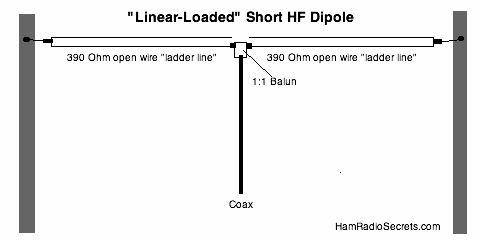For many ham radio operators, it is not feasible to put up a a full length dipole on HF.
But, a linearly loaded dipole just might fit in your available space!
A linearly loaded dipole, as illustrated below...
- ... is about 30-35% shorter than a "classic half-wave dipole" at the same frequency of resonance!
- ... has a radiation resistance around 35 Ohms. (You will need an impedance matching tuner at the other end of the coax!)
- ... just as effective as a "full length" half-wave dipole! :-)
Note that it "looks" like a folded dipole, but the top part is open!
You should add a ceramic end-insulator in the opening, to add
mechanical strength. (The insulator is omitted in the drawing to make
the opening obvious;-).
Shorter Dimensions!
Here are "ballpark" dimensions for a linearly loaded dipole for each ham radio band. These dimensions are intentionally slightly long! You will have to obtain the final dimensions experimentally, on site, by "pruning" to resonance.
Forgot the technique to prune a dipole to resonance? Refresh your memory on the page about the
ham radio dipole!
Linearly-Loaded Dipole
Approximate Dimensions |
10 meters (28.5 MHz)
12 meters (24.9 MHz)
15 meters (21.1 MHz)
17 meters (18.1 MHz)
20 meters (14.1 MHz)
30 meters (10.1 MHz)
40 meters (7.1 MHz)
80 meters (3.6 MHz)
160 meters (1.85 MHz) |
3.5 m. (11.5 ft.)
4.0 m. (13.2 ft.)
4.73 m. (15.5 ft.)
5.51 m. (18.1 ft.)
7.08 m. (23.2 ft.)
9.89 m. (32.44 ft.)
14.06 m. (46.14 ft.)
27.74 m. (91.0 ft.)
53.97 m. (177.08 ft.) |
Construction Of Linear Loaded
Short Ham Antennas
I use commonly available 390 Ohm "ladder line" with #14 stranded, copper-clad conductors. It is sturdy and lasts for years.
For the central "attachment" I use two LadderLoc center insulators, head-to-head (available at Radio Works).
I recommend 3/16 in. Mil Spec Dacron® rope to tie the ends to tall supports such as trees.
Bonus Configurations!
Linear-loaded short ham antennas do not have to be limited to horizontal installations!
You can save even more space by installing them as "slopers", inverted "V"s and inverted "U"s.


